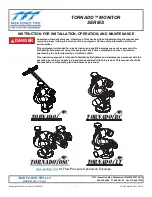
WavePro 7Zi
335
WP700Zi-OM-E-RevA
1951.22. This is far above the maximum it is reasonable to use. See the note on
computation time
under
"Operational Notes" below.
x
"Acquisition too small to apply EQ filters": The valid region of the waveform is reduced by EQ spacing on
each side. This error message means that the result would then have no valid points.
x
"LP fc low & sample rate too high, can't EQ filter": This message is shown if current EQ spacing is greater
than 8191 samples, an implementation restriction. The EQ spacing is set to correspond to 2T, assuming
that the cutoff frequency is correctly set; it is calculated from the cutoff frequency as follows:
EQ spacing in samples = 2.0/(fc * 26.16/8.2) * sample interval
Operational Notes
1.
Even if the input data is already equalized, it is often helpful to tell the ODATA function that it is not, but set
the boost to zero. This greatly reduces noise. White noise has power per Hz of bandwidth, and reducing
the scope's bandwidth to around 8.2 MHz gets rid of 99% of white noise.
2.
Applying high-frequency boost makes short pulses larger and has less effect on longer pulses. The correct
boost should not greatly increase the signal's overall amplitude.
3.
The output of the equalization is not delayed, as it would be by an analog filter. We compensate for the
known delay through the digital filter and replace each input point with the corresponding equalized point.
4.
The FIR LP filter plus 3.2 dB boost from the three-tap EQ filter produces the transfer function shown in the
next figure when the FIR fc is set to 8.2 MHz. The highest peak is 20 log (dB) magnitude. The bowed trace
below it is the real component of the TF. The flat line at zero is the imaginary component of the TF. It is
zero indicating that there is no delay at all from input to output.
5.
The computation time for the low-pass filter is generally longer than the time required for the sum of the
rest of the computations done by the ODATA math function. This is because the low-pass filter is a finite
impulse response filter (emulating the shape of a 6th order Bessel filter). It can require hundreds of
multiplies-and-adds per sample in the waveform. The higher the sample rate relative to the bit time, T, the
longer the FIR is. It is adequate to sample at 10 to 20 times the channel bit time, T. For 1x DVD, T is 26.16
MHz. Twenty times that is 523 MHz, so 500 MS/s is a good sample rate.
6.
The three-tap EQ filter uses as input the point to be replaced and the points 2T away on each side. Since
2T may not correspond to an integer number of scope samples, linear interpolation between scope
samples is used to get the values at exactly 2T away on each side.
Содержание DDA 7 Zi series
Страница 1: ...Operator s Manual WavePro SDA and DDA 7 Zi Series Oscilloscopes ...
Страница 2: ... L R R H HUD RU D D ...
Страница 41: ...Operator s Manual WP700Zi OM E RevA 40 The detachable WavePro Zi front panel ...
Страница 376: ...WavePro 7Zi 375 WP700Zi OM E RevA Absolute Offset Relative ...
Страница 439: ...Operator s Manual WP700Zi OM E RevA 438 ...
Страница 440: ...WavePro 7Zi 439 WP700Zi OM E RevA ...
Страница 544: ...Thank you for purchasing a WavePro SDA or DDA 7 Zi Oscilloscope ...
















































